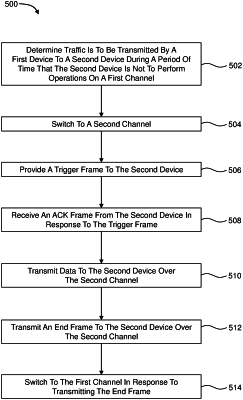| CPC H04W 72/12 (2013.01) [H04B 7/155 (2013.01); H04W 48/10 (2013.01); H04W 84/12 (2013.01)] | 19 Claims |

|
1. A method comprising:
obtaining, by a repeater configured to communicate according to a dual band virtual concurrent (DBVC) protocol, a next root access point (AP) target beacon transmission time (TBTT) of a next beacon to be sent by a root AP;
determining an amount of time to delay a next repeater TBTT of a next beacon to be sent by the repeater to avoid conflict between the next root AP TBTT and the next repeater TBTT; and
delaying the next repeater TBTT based on the determined amount of time,
wherein determining the amount of time to delay comprises:
summing the next root AP TBTT with a repeater beacon interval of the repeater to generate an intermediate sum; and
subtracting from the intermediate sum an amount of time for the repeater to perform DBVC off channel operations, an amount of time that will cause the next repeater TBTT to avoid occurring during DBVC off channel operations of the repeater, and the next repeater TBTT to generate a difference, the difference being the amount of time to delay.
|